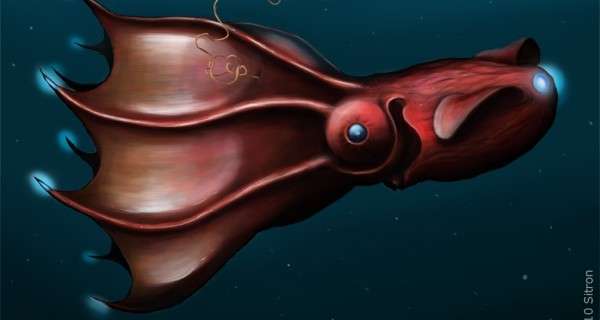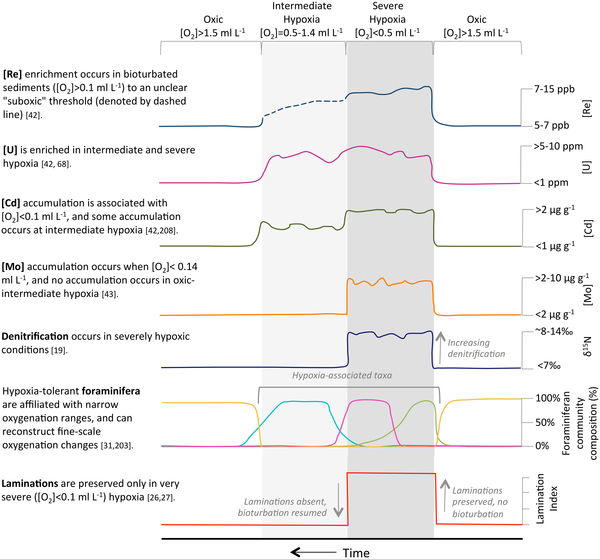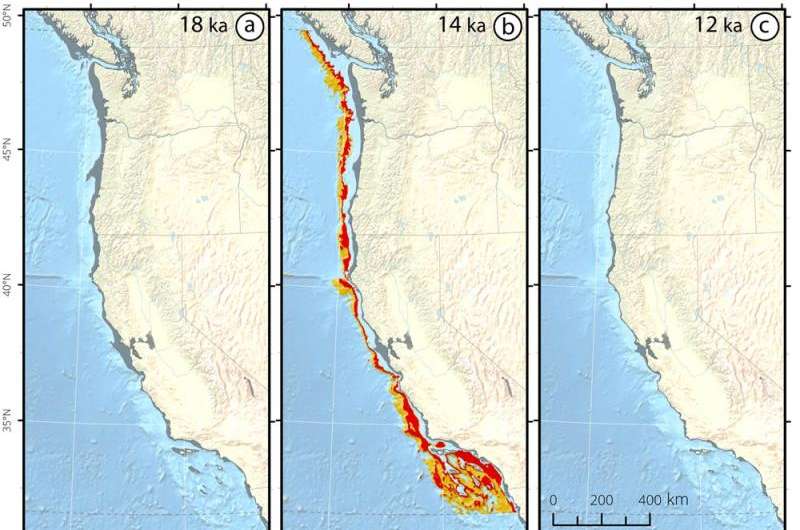Reconstructing past oxygen minimums with an eye to the future

A recent paper published in PLOS ONE uses geochemical and fossil evidence from the period of global warming at the end of the last ice age to reconstruct the depth and extent of ocean areas with dissolved oxygen below those necessary for most organisms to function. The results show that warming was associated with increases in the extent of hypoxic zones, and that these zones also intruded further toward the surface of the oceans near continental margins, areas with high species density and diversity. The results provide an example of how oceans may respond as the climate warms under current global warming scenarios.
As anyone who has ever decided to hold their breath for awhile knows, oxygen is critical for maintaining life. But we are terrestrial organisms, living in a well mixed atmosphere, so it is rare to encounter areas with oxygen scarce enough to threaten life. Finding them requires going deep underground or high in the mountains, or falling victim to a dangerous domestic mishap with a gas line. For aquatic organisms though, oxygen depletion is a real and present danger. The amount of oxygen in water is temperature dependent, and temperature can also increase the growth of organisms that use this oxygen. Thus, fresh and ocean water can become depleted of oxygen (hypoxic) when temperatures are high or microorganisms use oxygen faster than it is being added. The resulting "dead zones" in the worlds oceans have been a source of worry and debate for ocean and climate scientists, and the rising temperatures due to global climate change have been cited as a potential factor in increasing extent and frequency of ocean "dead zones."
These hypoxic zones, when they appear, can be devastating to ocean ecosystems, and can severely affect fisheries and therefore human livelihood and nutrition. Perhaps the most famous example is the growing hypoxic zone in the Baltic sea, which threatens lobster and cod fisheries. One particular hypoxic zone in the ocean is known as the Oxygen Minimum Zone (OMZ). This is a zone of the ocean at which oxygen is stripped from the water (usually through decay of falling organic matter) at a rate that exceeds the mixing of oxygen from the surface. The depth and extent of this zone varies due to changes in major ocean currents as well as temperature and, except for a relative few specialized organisms such as the vampire squid and certain bacteria, cannot support ocean life. Researchers have warned that increasing human inputs (paywall) into the ocean, as well as increasing global temperatures could increase the extent of the OMZ, especially affecting nearshore areas and fisheries (open access, PLOS Biology).

These results have largely been based on current observational data showing increases in hypoxic zones and model predictions but a recent paper, published in PLOS ONE, provides evidence from a past global warming episode which may shed light on how the OMZ will respond to future global warming scenarios. Observational data can be critical for validating model results and increasing our ability to predict future events.
Dr. Moffitt and her colleagues analyzed sediment cores from the ocean floor deposited during the last ice-age deglaciation, the last time global temperatures exhibited a large warming trend. These sediment cores were analyzed for seven geochemical, fossil, and sediment structure proxys which indicate the presence of hypoxia in the waters above. The concentration of elements uranium, rhenium, cadmium and molybdenum, as well as denitrification, all increase when waters above are hypoxic and these chemicals are not taken up in biological interactions. Further, the species composition of foraminifera which fall to the ocean bottom is distinct in hypoxic zones. Finally, the sediments themselves have a characteristic laminated structure when waters are hypoxic because there are no benthic organisms to stir up the fine layers of sediment. In addition, Moffitt and her colleagues reconstructed the past ocean depths to infer the depth and extent of the OMZ during the end of the last ice age.
Their results show that as carbon dioxide and temperature rose in the atmosphere during deglaciation, the extent of the OMZ expanded dramatically along the western coasts of North and South America and in the subarctic zone of the North Pacific. Further, the depth of the hypoxic zone became shallower, substantially decreasing the habitable oxygenated zone near the surface. These changes to the OMZ also tightly tracked the deglaciation changes, indicating that they were related to climate warming and not forced by other factors.
These results are important in the context of current anthropogenic climate change. Humans depend, to a large degree, on ocean ecosystems for food. Ocean ecosystems also make up a large economic sector. However, this research adds to a growing list of studies indicating that warming temperatures may disrupt ocean ecosystems. In the case of the OMZ, shallower and larger hypoxic zones on the continental margins will result in less habitable area for important aquatic species which could have negative affects on the organization of species as well as the sustainability and productivity of fisheries.

More information: Sarah E. Moffitt et al. Paleoceanographic Insights on Recent Oxygen Minimum Zone Expansion: Lessons for Modern Oceanography, PLOS ONE (2015). DOI: 10.1371/journal.pone.0115246
Camilo Mora et al. Biotic and Human Vulnerability to Projected Changes in Ocean Biogeochemistry over the 21st Century, PLoS Biology (2013). DOI: 10.1371/journal.pbio.1001682
Journal information: PLoS Biology , PLoS ONE
Provided by Public Library of Science
This story is republished courtesy of PLOS Blogs: blogs.plos.org.




















